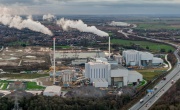Recycling is not sorted
Professor Edward Kosior, Managing Director of Nextek, argues the importance of shifting industry focus onto re-using waste, not just sorting it.
Given the ongoing regulatory changes and growing consumer outrage, plastic waste has finally reached a tipping point on organisations’ agenda. The risk for producers and users of virgin plastics is balanced by a unique opportunity for companies ahead of the curve to unlock value from a circular economy that derives revenue from the circulation of materials rather than the extraction and conversion of fossil fuels.
 As a consequence, we are seeing a series of new value pools created around improved materials and design through to cutting-edge sorting and recycling technologies, as well as smart collection and supply chain management systems.
As a consequence, we are seeing a series of new value pools created around improved materials and design through to cutting-edge sorting and recycling technologies, as well as smart collection and supply chain management systems.
Yet there is an unhelpful misconception currently pervading industry that relates to sorting. Despite the highlight on innovative sorting processes and the high level of interest around cutting edge sorting technology, sorting alone will not solve our recycling woes.
The hard truth is that sorting is only part of the journey towards a true circular economy, where we use our resources sustainably and stop creating un-manageable waste.
Of course, sorting is a vital facet of the entire process, but we need to go way beyond merely sorting our waste if we are to make any meaningful shift in the way we manage our current waste levels.
As organisations seek to avoid the forthcoming hefty plastic packaging taxes that are looming, sorting appears to be grabbing the headlines as the way forward. There is always significant debate around which type of sorting process will deliver the best results.
Ultimately, regardless how waste is actually identified and sorted, we will still end up with a pile of well-sorted waste that is of low value unless it can be properly re-used, and this requires cutting-edge extrusion, filtration and decontamination.
If we are to make better use of our plastic packaging waste we need to turn it back into high quality recycled mon-polymers. Brand owners and retailers are desperately short of food-grade recycled plastic.
Any organisation involved in FMCG is going to have to drastically curb their dependence on virgin plastic if they are to comply with the new plastic packaging laws. To achieve this will require having a vast and new supply of food-grade recycled polypropylene and other polymers to turn into the tubs, pots and trays they are using since polypropylene is one of the largest volume plastics used globally.
Yet, as it stands, the focus seems to have got locked onto a debate on which sorting solution will help them achieve this. However, whether we opt for chemical markers (such as fluorescent marker-based PRISM) or digital watermarks, the very fact that we can now enhance the sorting and identification processes is only one step in the right direction.
Decontamination is the next crucial phase, without which we are only addressing one half of the challenge as we still will not be able to turn our well sorted waste into valuable recyclates such as food-grade rPP and food grade rHDPE.
Achieving the vision of near-zero plastic waste requires technological advances, brave new thinking, innovative business models as well as accelerating upstream innovation.
It has taken eight years of intense research and commercial trials to achieve a powerful and unique decontamination process for food-grade recycled PP that is shortly going for EFSA and USFDA approval. This is in effect the missing link that will finally close the loop on a food-grade plastic that has been “missing-in-action” to date.
Unlocking the full value of our plastic waste will go a long way towards helping organisations honour their commitment to increase the level of recycled material they use in their packaging - better still this kind of coherent recycling strategy will have an enormous impact on reducing post-consumer waste.
According to the recent PEW report, Breaking the Plastic Wave, the present value of global investments in the plastic industry between 2021 and 2040 can be reduced from US$ 2.5 trillion (±US$ 800 billion) to US$ 1.2 trillion (±US$ 300 billion), but this will require a substantial shift of investment away from the production and conversion of virgin plastic.
Instead we need to focus on closing the plastic loop by taking each facet of the process from collection and sorting through to decontamination to ensure a transformational shift occurs.
In 2017 we produced 348 million metric tonnes of virgin plastic globally and this is expected to double in capacity by 2040. It is imperative that we acknowledge we can start making paradigm changes right now with the technologies we already have at our fingertips and this starts with embracing the entire recycling process, not just focusing on one element of it.




